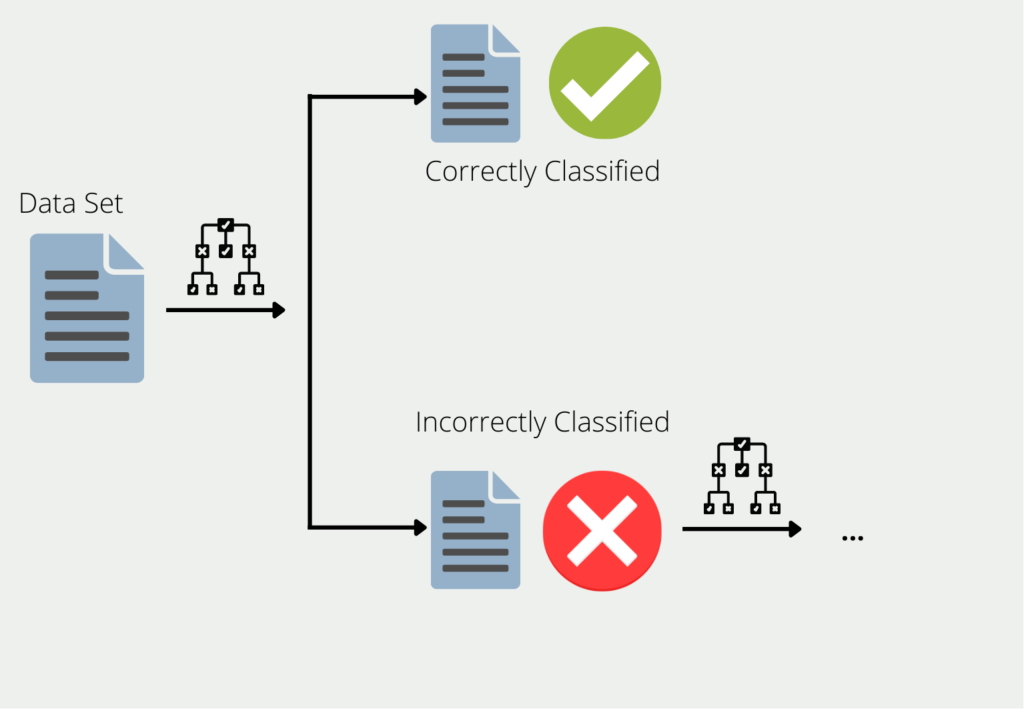XGBoost stands for Extreme Gradient Boosting and is an open-source machine learning library. It offers standard machine learning algorithms that use the so-called boosting algorithm. The library is extremely efficient with memory and computing power and thus delivers high performance when training the models.
What is Boosting?
In machine learning, not only individual models are used. In order to improve the performance of the entire program, several individual models are sometimes combined into a so-called ensemble. A random forest, for example, consists of many individual decision trees whose results are combined into one result.
Boosting describes the procedure of combining multiple models into an ensemble. Using the example of decision trees, the training data is used to train a tree. For all the data for which the first decision tree gives bad or wrong results, a second decision tree is formed. This is then trained using only the data that the first one misclassified. This chain is continued and the next tree in turn uses the information that led to wrong results in the first two trees.

The ensemble of all these decision trees can then provide good results for the entire data set since each individual model compensates for the weaknesses of the others. This is also referred to as combining many “weak learners” into one “strong learner”.
What is Gradient Boosting?
Gradient boosting, in turn, is a subset of many, different boosting algorithms. The basic idea behind it is that the next model should be built in such a way that it further minimizes the loss function of the ensemble.
In the simplest cases, the loss function simply describes the difference between the model’s prediction and the actual value. Suppose we train an AI to predict a house price. The loss function could then simply be the mean squared error between the actual price of the house and the predicted price of the house. Ideally, the function approaches zero over time and our model can predict correct prices.
New models are added as long as prediction and reality no longer differ, i.e. the loss function has reached the minimum. Each new model tries to predict the error of the previous model.
Let’s go back to our example with house prices. Let’s assume a property has a living area of 100m², four rooms, and a garage and costs 200,000€. The gradient boosting process would then look like this:
- Training a regression to predict the purchase price with the features of living space, the number of rooms, and the garage. This model predicts a purchase price of 170,000 € instead of the actual 200,000 €, so the error is 30,000 €.
- Training another regression that predicts the error of the previous model with the features of living space, number of rooms, and garage. This model predicts a deviation of 23,000 € instead of the actual 30,000 €. The remaining error is therefore 7,000 €.
These steps are repeated until the remaining error is as small as possible or even zero.
What are the Advantages and Disadvantages of Boosting in General?
The general advantage of boosting is that many weak learners are combined into one strong and powerful model. Despite a large number of small models, these boosting algorithms are usually easier to compute than comparable neural networks. However, this does not necessarily mean that they also produce worse results. In some cases, ensemble models can even beat the more complex networks in terms of accuracy. Thus, they are also interesting candidates for text or image classification.
Furthermore, boosting algorithms, such as AdaBoost, also tend to overfit less. This simply means that they not only perform well with the training dataset but also classify well with new data with high accuracy. It is believed that the multilevel model computation of boosting algorithms is not as prone to dependencies as the layers in a neural network, since the models are not optimized contiguously as is the case with backpropagation in the model.
Due to the stepwise training of single models, boosting models often have a relatively slow learning rate and therefore need more iterations to deliver good results. Furthermore, they require very good data sets, since the models react very sensitively to noise and this should be removed in the data preprocessing.
What are the Advantages of using XGBoost?
The XGBoost library provides the ability to train large data sets with proven Machine Learning algorithms while optimizing computational performance. In addition, XGBoost offers these benefits:
- Open source platform for various programming languages, such as Python or R.
- A large number of users and developers continuously develop the platform.
- Algorithms for a variety of use cases, such as classification or regression.
- Flexible and high-performance training of machine learning models, which can also be moved to the cloud.
What are the limitations of Gradient Boosting models?
Gradient boosting is a popular choice for a wide range of applications as it can be adapted to a variety of scenarios. However, despite these numerous advantages, there are also some disadvantages or limitations that should be considered when using it:
- Overfitting: Gradient boosting is prone to overfitting if the hyperparameters are not set optimally or the model complexity is too high. This impairs the generalization performance so that the model does not provide good predictions for new data.
- Time and resource consumption: Another problem with boosting methods in general is the extended training time, as more models are trained, which take up computing resources. Therefore, with gradient boosting, care should be taken to define the maximum depth of the trees and the number of leaves in order to limit the computational effort.
- Limited interpretability: The combination of different models makes it very difficult to interpret a single prediction. This turns the model into a black box so that the conclusions cannot be directly understood. If a transparent model with good interpretability is required for the application, it is better to use a single decision tree.
- Pre-processing of the data: The model performance of a gradient boosting model is also largely dependent on the pre-processing of the data. This includes, for example, categorical variables being coded or the features being scaled. If this is not the case, it can have a significant negative impact on model performance. In addition, outliers often lead to poorer results and should therefore be removed from the data set.
- Unbalanced data: For classification tasks, the balance of the data set is immensely important in order to train a meaningful gradient boosting model. Otherwise, this can lead to significantly distorted models.
In conclusion, gradient boosting is a powerful method that has many benefits. If the points mentioned in this section are taken into account during training, nothing stands in the way of a high-performance model.
Which Applications can be solved with XGBoost?
The XGBoost library was developed to provide high computing power during training and to parallelize and accelerate the training. This is ensured by the already explained gradient boosting, which combines many, so-called weak learners into one powerful model.
These are several decision trees that are not combined into an ensemble as in the case of a random forest but are combined with each other according to the gradient boosting algorithm in order to ensure optimal performance. Accordingly, the same fields of application can be implemented as with conventional decision trees.

The decision trees are used for classifications or regressions depending on the target variable. If the last value of the tree can be mapped to a continuous scale, we speak of a regression tree. On the other hand, if the target variable belongs to a category, we speak of a classification tree.
Due to its simple structure, this type of decision-making is very popular and is used in a wide variety of fields:
- Business management: Opaque cost structures can be illustrated with the help of a tree structure and make clear which decisions entail how many costs.
- Medicine: Decision trees help patients to find out whether they should seek medical help.
- Machine Learning and Artificial Intelligence: In this area, decision trees are used to learn classification or regression tasks and then make predictions.
Which Boosting algorithm should you choose?
Various boosting algorithms are available in the field of machine learning, all of which have advantages and disadvantages. Choosing the right model can therefore quickly become difficult and depends on various factors, such as the size of the data set and the degree of interpretability.
In this section, we provide a brief overview of the three most important boosting algorithms and when they should be selected:
- AdaBoost (Adaptive Boosting) is a popular choice for classification tasks. It combines several weak classifiers and trains them in several iterations. The iterations differ in that the training samples are given weights and thus a new classifier is trained. This allows the boosting algorithm to focus more on the misclassified training samples. AdaBoost is therefore suitable for classification tasks with medium-sized data sets.
- XGBoost (Extreme Gradient Boosting) uses decision trees as a basis and also relies on regularization to prevent overfitting. This means that even large data sets with high-dimensional features can be processed. In addition, both regression and classification tasks can be implemented particularly efficiently. This makes XGBoost a very broad-based model that can be used for many applications.
- Gradient boosting is a very general approach that can be individualized with different loss functions and underlying models. By combining different weak learners, a strong learner is formed that minimizes the loss function as much as possible. This flexible structure allows different data types, in particular categorical features, to be mapped.
AdaBoost is therefore primarily used for simple classification tasks with small to medium-sized data sets. For large data sets with high-dimensional features, on the other hand, XGBoost is a good choice, as the regularization effectively prevents overfitting. Gradient boosting, on the other hand, is to a certain extent the middle ground between these two approaches.
This is what you should take with you
- XGBoost stands for Extreme Gradient Boosting and is an open-source Machine Learning library.
- XGBoost offers common machine learning algorithms that use the so-called boosting algorithm. This is used to combine multiple decision trees into a high-performance ensemble model.
- The advantages of XGBoost are the efficient use of computing power and the good results that the models deliver in many use cases.
- Nevertheless, neural networks have already been able to beat the already good results of XGBoost models in many comparative experiments.
What is the Adam Optimizer?
Unlock the Potential of Adam Optimizer: Get to know the basucs, the algorithm and how to implement it in Python.
What is One-Shot Learning?
Mastering one shot learning: Techniques for rapid knowledge acquisition and adaptation. Boost AI performance with minimal training data.
What is the Bellman Equation?
Mastering the Bellman Equation: Optimal Decision-Making in AI. Learn its applications & limitations. Dive into dynamic programming!
What is the Singular Value Decomposition?
Unlocking insights and patterns: Learn the power of Singular Value Decomposition (SVD) in data analysis. Discover its applications.
What is the Poisson Regression?
Learn about Poisson regression, a statistical model for count data analysis. Implement Poisson regression in Python for accurate predictions.
What is blockchain-based AI?
Discover the potential of Blockchain-Based AI in this insightful article on Artificial Intelligence and Distributed Ledger Technology.
Other Articles on the Topic of XGBoost

Niklas Lang
I have been working as a machine learning engineer and software developer since 2020 and am passionate about the world of data, algorithms and software development. In addition to my work in the field, I teach at several German universities, including the IU International University of Applied Sciences and the Baden-Württemberg Cooperative State University, in the fields of data science, mathematics and business analytics.
My goal is to present complex topics such as statistics and machine learning in a way that makes them not only understandable, but also exciting and tangible. I combine practical experience from industry with sound theoretical foundations to prepare my students in the best possible way for the challenges of the data world.





